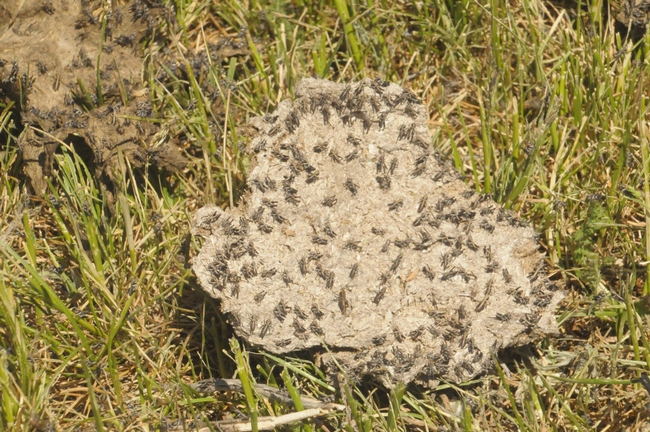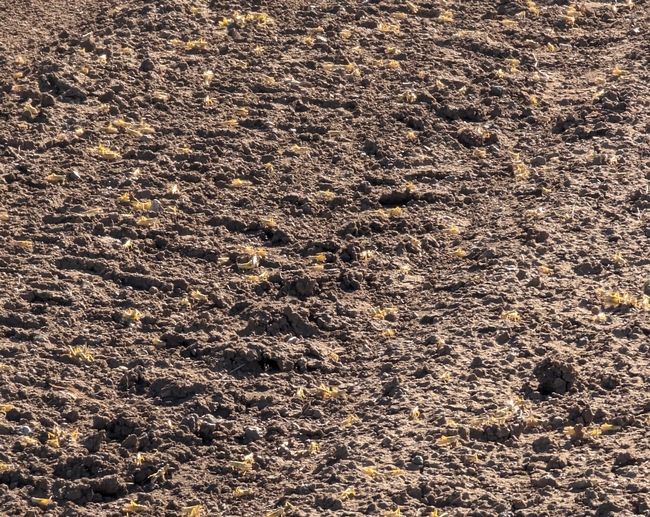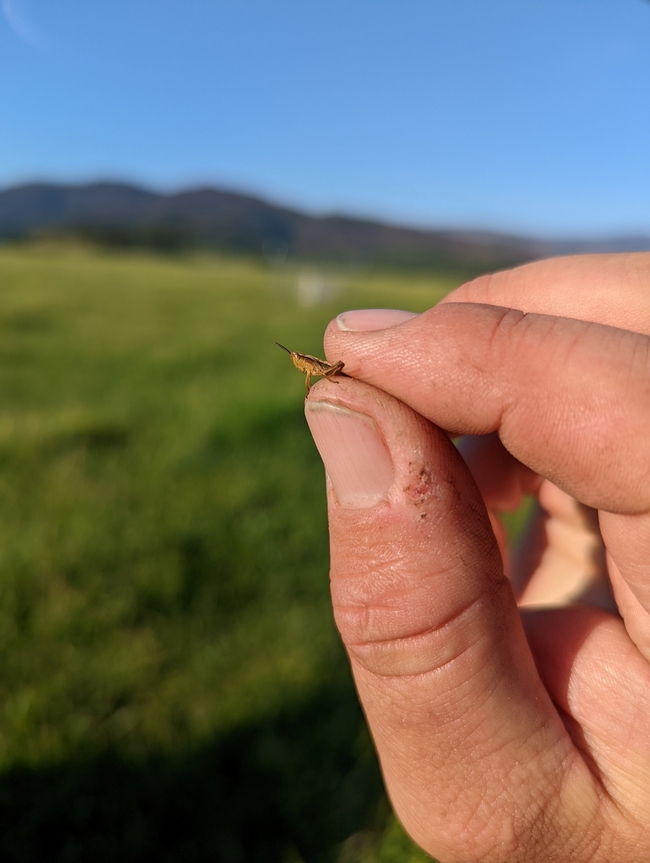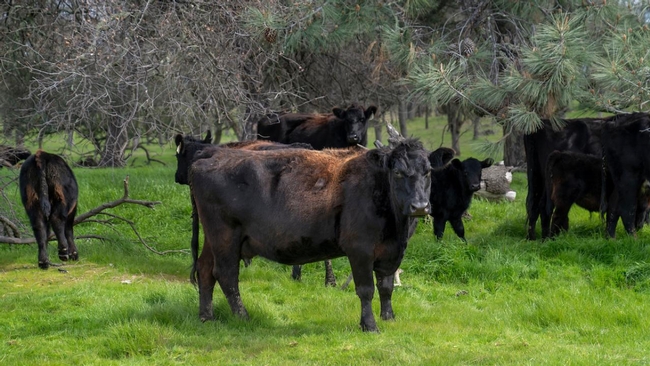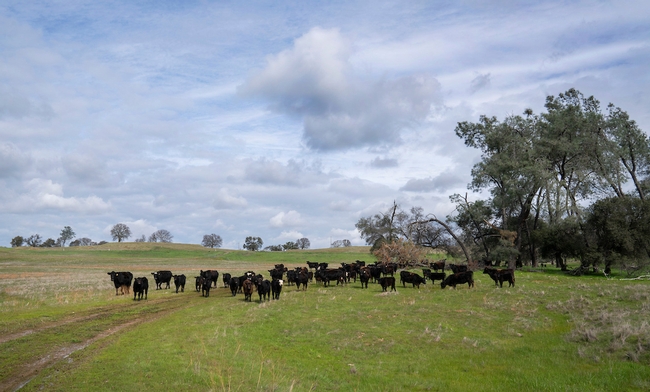
Posts Tagged: tom
Grasshoppers gobble crops, farm profits
UCCE advisors share control, abatement strategies across Northern California
That buzzing noise in Northern California is the sound of grasshoppers chewing a path of destruction through crops and pollinator-friendly plants as they hop across an expanding area.
This is the fifth year in a row that massive numbers of grasshoppers have overrun Modoc County and “probably the worst I've seen yet,” said Laura Snell, a University of California Cooperative Extension livestock and natural resource advisor in Modoc County, located in the northeastern corner of the state.
In past years, Snell has heard from farmers who have lost up to 70% of their hay crop. This year, she is hearing of grasshopper damage from farmers who grow a wider array of crops, including onions and garlic – crops that the pests eschewed in past years.
“I've had an even broader group of producers contact me about damage,” Snell said. “Our local vegetable producers are being affected, decreasing farmers market and food hub products. Bee producers are not seeing good honey yields due to grasshoppers eating huge amounts of pollinator plants.”
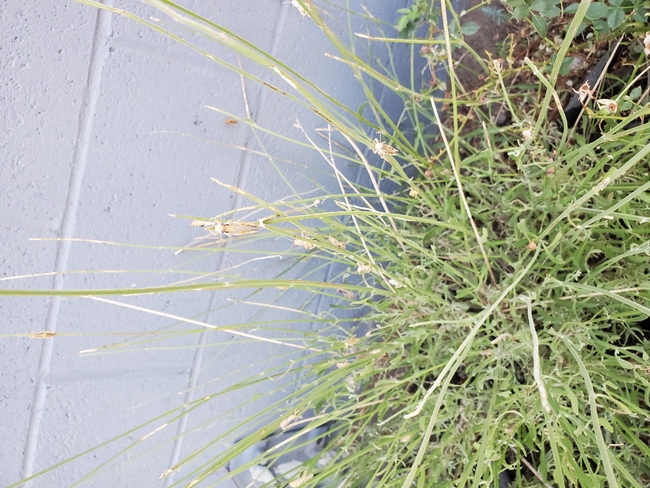
Modoc County isn't alone. Lassen, Sierra, Plumas, Siskiyou, Tehama, Butte, Placer and Nevada counties are being invaded by grasshoppers.
“The county ag commissioners are circulating a survey to get an idea of other counties that may be affected,” Snell said. “Things like droughts and – I suppose, fires as well – would affect grasshopper migrations.”
While scientists don't know what's causing the explosive growth of grasshopper populations, there are some contributing factors, according to Tom Getts, UC Cooperative Extension weed ecology and cropping systems advisor for Lassen, Modoc, Plumas and Sierra counties.
In the past, grasshopper outbreaks seemed to be more isolated, and the populations tended to crash after a year or two. Getts said, “For whatever reason, the population cycle does not appear to have been broken, and they continue to have high numbers.”
Grasshoppers can consume 30% to 250% of their body weight per day, according to a fact sheet about grasshoppers, co-authored by Getts. While grasshopper nymphs walk, adults can fly 15 miles or more.
Getts and UC Cooperative Extension farm advisors have been giving presentations throughout the intermountain region on grasshoppers and the various control methods.
“The difficulty to controlling them is the scale and their ability to move,” Getts said. “The insects need to be targeted at a small growth stage for the tactics to be most efficacious. Once they are adults, it doesn't matter what one grower does to control them if their neighbor doesn't do anything.”
UCCE farm advisors in multiple counties are working on abatement options.
They recommend monitoring in April–May to control grasshoppers while they are still nymphs and susceptible to insecticides. Birds, spiders, rodents and fungi also can help keep the insects in check, but years of drought have reduced the fungi.
“The population of grasshoppers in the region have increased in size, scope and density in recent years,” said Rob Wilson, a UC Cooperative Extension agronomy and pest management advisor and director of the Intermountain Research and Extension Center in Tulelake.
The massive growth and spread of the pests is a problem because 30 pounds of grasshoppers can eat as much forage as a 600-pound cow can eat per day, he explained.
Part of the challenge of controlling grasshoppers is their changing behavior. In the past, grasshoppers would go away after a couple of years, now they persist. They used to thrive in dry fields, but last year, grasshoppers migrated 10 to 20 miles into irrigated fields, Wilson said.
Wilson, who has been monitoring grasshoppers near Tule Lake since early April, said that In some fields, there were 20 to 30 nymphs per square yard. More than eight nymphs per square yard can cause economic damage.
As if the grasshoppers themselves weren't enough of a nuisance, they attract other pests, including blister beetles.
“As the grasshopper population increases, you are bound to see an increase in all of the species that eat them over time,” Getts said. “Blister beetles cause terrible blisters when they get on your skin, hence the name, but they can also be problematic for livestock if they contaminate bales of hay.”
Getts recommends that growers take steps to prevent grasshopper populations from building over successive years. Growers should coordinate with neighboring growers to treat their fields due to the limited longevity and efficacy of treatments on individual fields.
[Editor's note: The sentence comparing the appetite of grasshoppers to that of cows was revised to clarify that grasshoppers aren't eating cows.]
European Wool Carder Bees Are on the Move
Seen any European wool carder bees lately? European wool carder bees (so named because the female...
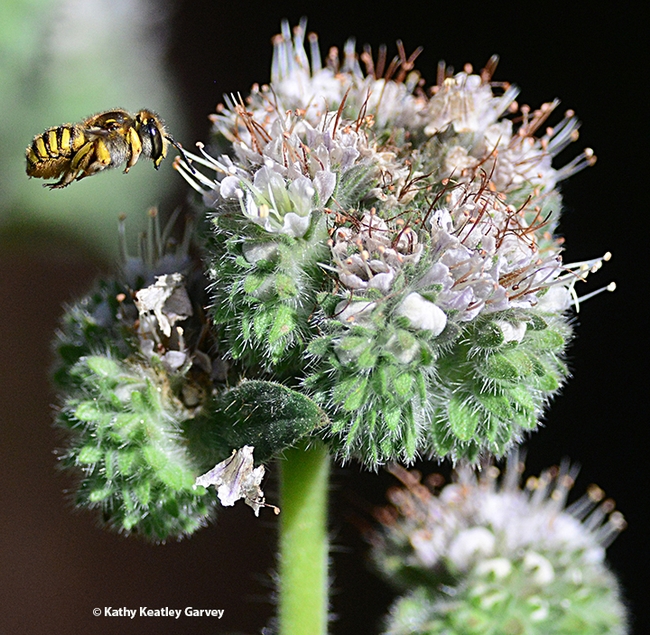
A European wool carder bee in flight. (Photo by Kathy Keatley Garvey)
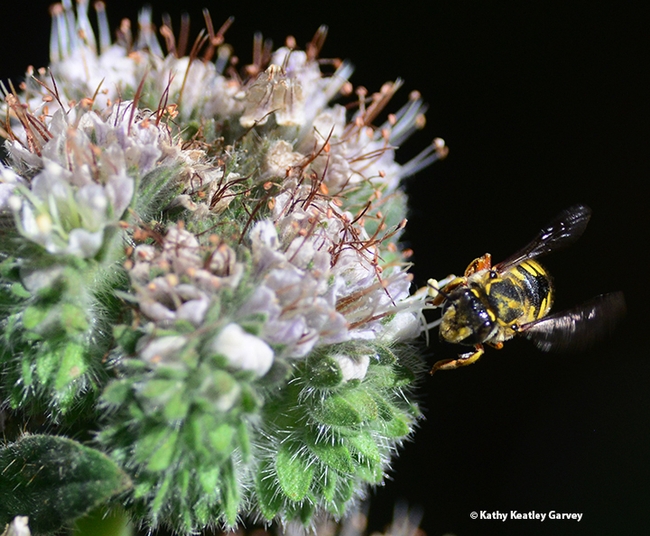
European wool carder bees are difficult to photograph when they're zipping around. (Photo by Kathy Keatley Garvey)
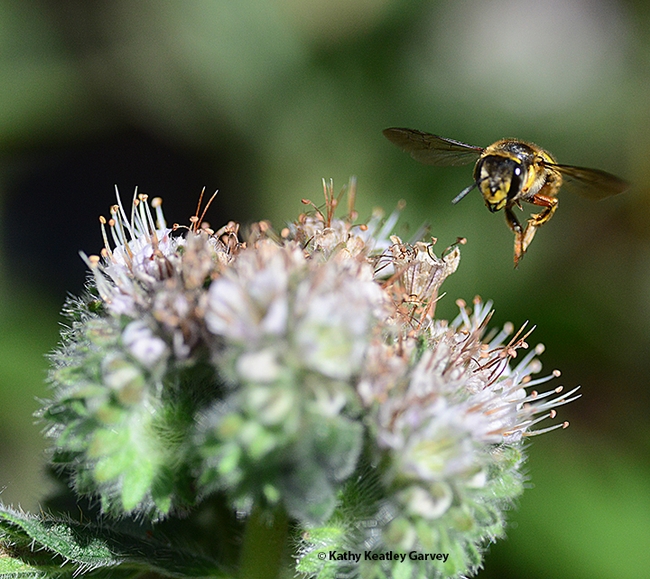
Make way! This European wool carder lets everyone know who's boss. (Photo by Kathy Keatley Garvey)
International Insect Salon: From 'Bugs Love' to 'Syrphid Feeding' to 'Monarch Laying Eggs'
If you attended the Entomological Society of America's 2021 meeting last week in Denver, you...

This image, "Monarch Laying Eggs," by Joe Virbickis of Washington, Ill., won the medal for "Best by Peoria Camera Club Member." (Copyright Joe Virbickis)
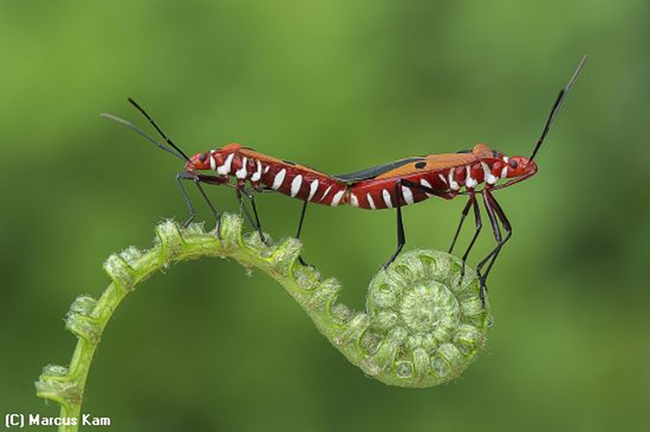
Best of Show went to Marcus Kam of Malaysia for this image, "Bugs Love." (Copyright Marcus Kam)
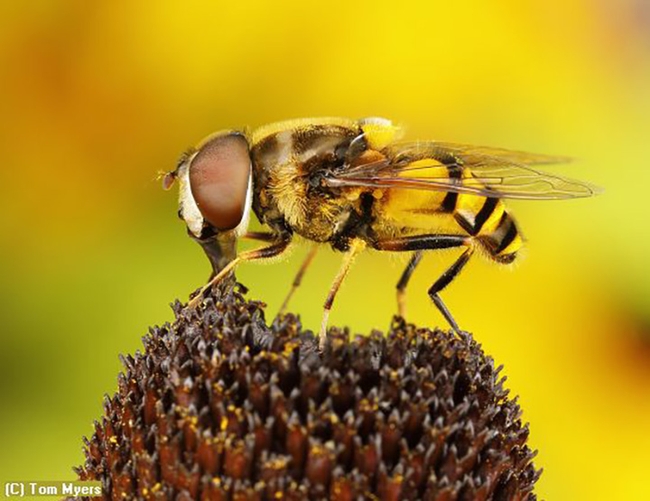
Entomologist Tom Myers won "Best by ESA Member" for this image of a syrphid fly. (Copyright Tom Myers)

One of the California-based images accepted in the 2021 international Insect Salon was this one by ESA member Kathy Keatley Garvey, of Gulf Fritillaries "Keeping Busy." (Copyright Kathy Keatley Garvey)
California’s local meat suppliers struggle to stay in business
UC Davis report suggests ways to build resilience
The University of California, Davis, Food Systems Lab has released a white paper showing the need to support California's small and mid-scale meat suppliers and processors in order to build a more resilient meat supply chain. It describes how the meat supply chain and rural economies could benefit from regulatory changes and more collaboration among producers and other stakeholders in the system.
The pandemic shut down meat processing plants in 2020, as did recent ransomware attacks on JBS, the nation's largest meat supplier. Report authors said this highlights the need to support small- and mid-scale suppliers.
“COVID and the ransomware attacks put a spotlight on how the concentration of the meat supply chain increased vulnerability in the food system,” said report co-author Tom Tomich, founder of the UC Davis Food Systems Lab and distinguished professor in the Department of Environmental Science and Policy. “We need to level the playing field so small- and mid-scale farms have an easier way to bring their product to market.”
The report says the lack of access to slaughter facilities, limited capacity of cut and wrap facilities, and concentration of marketing channels create conditions in which small- and mid-scale farms and ranches struggle to stay in business.
“These challenges are exacerbated by policies that tilt the playing field against small operators. Fortunately, new state and national legislation and programs are developing that could increase resilience in our food systems,” says Michael R. Dimock, Roots of Change program director and lead author for the report. “We need cities and counties to help fix the problems because local land use policies often impede development of resilient supply chains.”
Lack of access and limited capacity
Smaller ranchers in California have limited access to slaughter and processing facilities. In the last 50 years, California has lost half of its federally inspected meat processing plants, and the remaining facilities are unable to meet demand. Many of the 46 USDA-certified slaughter plants operating in California are closed to smaller producers.
“This means that smaller ranchers must drive hundreds of miles to reach a facility or have to wait months due to limited capacity,” said Tomich.
The report said a combination of federal, state and private investments could provide a broader geographic distribution of plants of differing scales. It also suggests expanding mobile, on-farm slaughter operations for sheep, goats and hogs, similar to those for beef.
Regulatory barriers and opportunities
Complex inspection requirements and other regulatory barriers make it difficult for small- and mid-scale producers to compete with big suppliers. The report suggests California create its own meat inspection program equivalent to the federal program to serve smaller ranchers. Prioritizing public procurement of local, high-value meat would also help expand market access for smaller producers.
Broader benefits of smaller operators
The report notes other beneficial roles of small- and mid-scale livestock operations, apart from the potential to increase resilience in our food system. Livestock grazing is a cheap and effective way to reduce wildfire risk. Supporting local meat processing also helps rural economies and creates community-based jobs.
The report was based on 27 interviews with people representing a wide spectrum of activities and points of view within the meat supply chain throughout the state. Authors are Courtney Riggle, Allan Hollander, Patrick Huber and Thomas Tomich of the UC Davis Food Systems Lab, and Michael R. Dimock with Roots of Change.
Funding for the study came from the TomKat Foundation and USDA Hatch Program.
European Carder Bees Do Like Snapdragons!
What a show! Last weekend we spotted female European wool carder bees (so named because they...
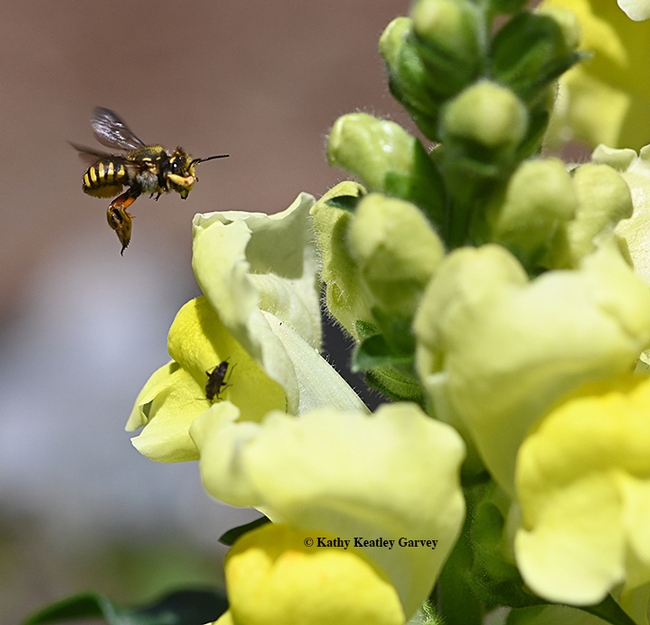
A male European wool carder bee patrolling snapdragons in Vacaville, Calif. (Photo by Kathy Keatley Garvey)
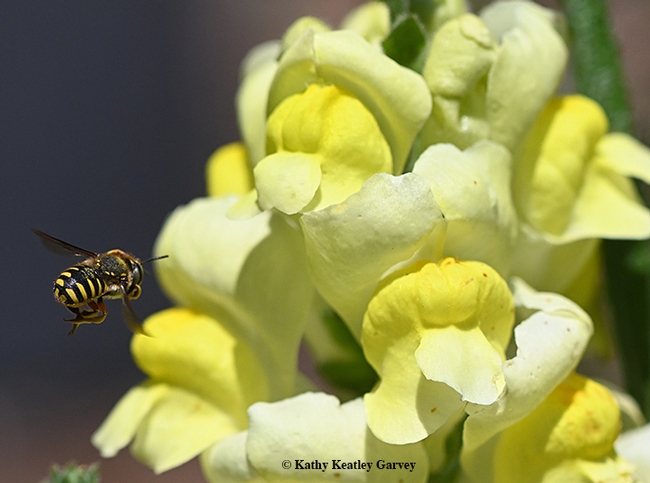
The European wool carder bee is about the size of a honey bee. (Photo by Kathy Keatley Garvey)
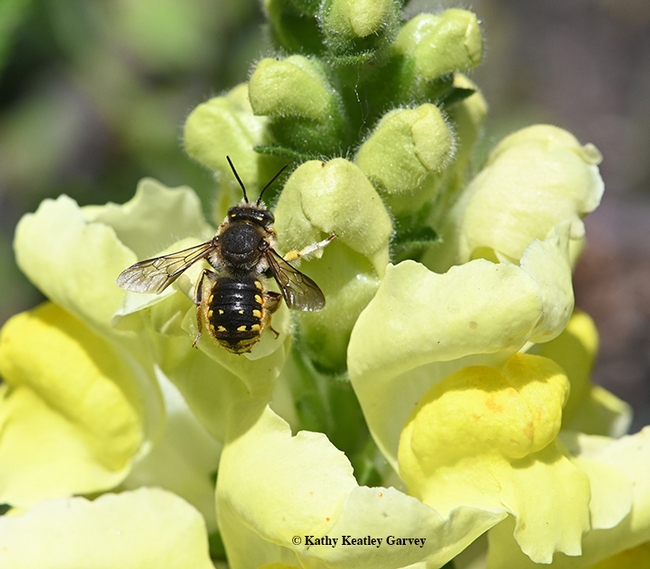
Dorsal view of the European wool carder bee as it rests on a snapdragon. (Photo by Kathy Keatley Garvey)
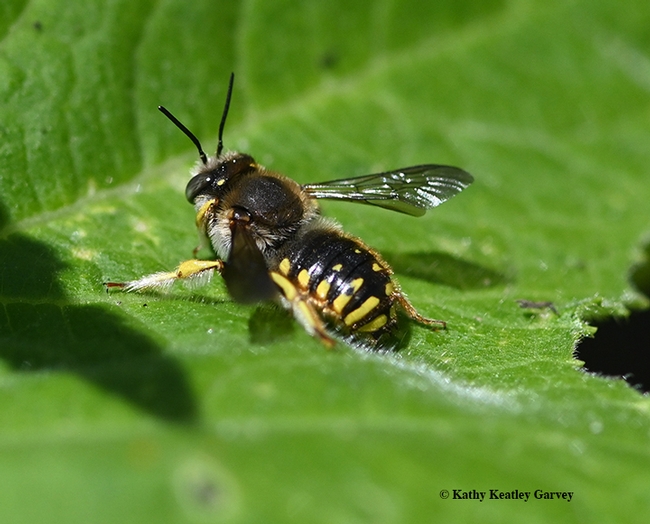
All that patrolling makes a fellow tired. A male European wool carder bee rests on a leaf. (Photo by Kathy Keatley Garvey)
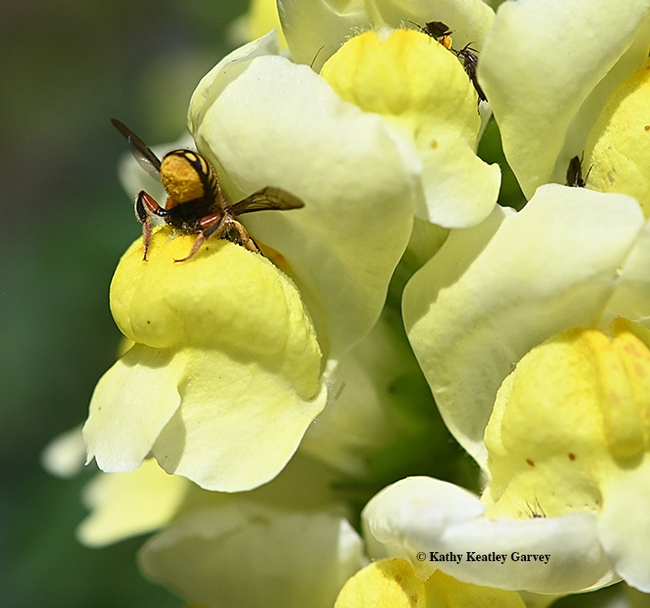
Bottoms up! A female wool carder bee foraging in a snapdragon. (Photo by Kathy Keatley Garvey)


